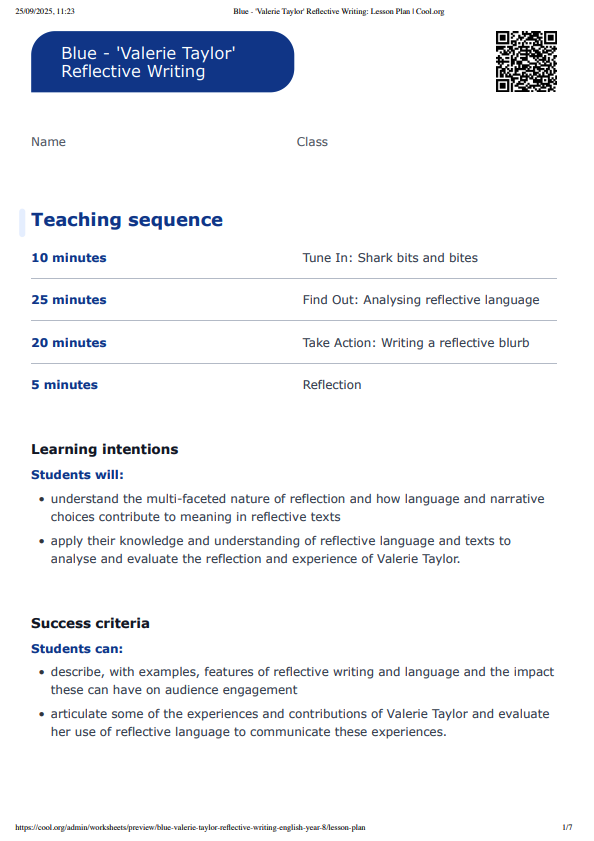Lesson summary
This lesson incorporates clips from Blue The Film as learning inspiration. In this finding out lesson, students will examine reflective language and reflective text structures. They will connect these with the experiences of people who’ve worked to make a difference, with a specific focus on Valerie Taylor. Using a selection of thinking, planning and writing tools, students will conduct an analysis of the role of biographical and reflective language in communicating experience to audiences in a way that can inspire others to take action. They will then create their own texts using reflective language.
Learning intentions:
Students will...
- understand the multi-faceted nature of reflection and how language and narrative choices contribute to meaning in reflective texts
- apply their knowledge and understanding of reflective language and texts to analyse and evaluate the reflection and experience of Valerie Taylor.
Success criteria:
Students can...
- describe, with examples, features of reflective writing and language and the impact these can have on audience engagement
- articulate some of the experiences and contributions of Valerie Taylor and evaluate her use of reflective language to communicate these experiences.
Lesson guides and printables
Curriculum links
Select your curriculum from the options below.
Lesson details
Skills
This lesson is designed to build students’ competencies in the following skills:
- communication
- creativity
- critical thinking
- digital literacy
- global citizenship
Curriculum Mapping
Australian curriculum (8.4) content descriptions:
Year 8 English:
- Analyse and evaluate the ways that text structures and language features vary according to the purpose of the text and the ways that referenced sources add authority to a text (ACELY1732)
- Recognise that vocabulary choices contribute to the specificity, abstraction and style of texts (ACELA1547)
Syllabus outcomes: EN4-3B
General capabilities: Literacy, Critical and Creative Thinking.
Cross-curriculum priority: Sustainability.
Relevant parts of Year 8 English achievement standards: Students explain how language features, images and vocabulary are used to represent different ideas and issues in texts. They listen for and identify different emphases in texts, using that understanding to elaborate on discussions. Students understand how the selection of language features can be used for particular purposes and effects. They explain the effectiveness of language choices they make to influence the audience. Students create texts for different purposes, selecting language to influence audience response. They take into account intended purposes and the needs and interests of audiences. Students demonstrate understanding of grammar, select vocabulary for effect and use accurate spelling and punctuation.
Unit of work: Blue The Film: Our Oceans and Our Future
Time required: 90 mins.
Level of teacher scaffolding: Low – lead students in discussion.
UN Sustainable Development Goals
- Target 14.1: By 2025, prevent and significantly reduce marine pollution of all kinds, in particular from land-based activities, including marine debris and nutrient pollution.
Resources Required
- Student Worksheet – one per student
- Device capable of presenting a website, clip and digital worksheet to the class
- Turtles Factsheet
- Seabirds Factsheet
- Sharks Factsheet
- Biographical Writing Factsheet
- Reflective Writing Factsheet
Additional Info
Blue is a feature documentary film charting the drastic decline in the health of our oceans. With more than half of all marine life lost and the expansion of the industrialisation of the seas, the film sets out the challenges we are facing and the opportunities for positive change. Blue changes the way we think about our liquid world and inspires the audience to action. Find out how to screen or download the film here. Along with the film is an ambitious global campaign to create advocacy and behaviour change through the #oceanguardian movement. To become an ocean guardian, see the website.
Related Professional Learning
How To Teach Sustainability With Hope
Quick summary: This course is for both primary and secondary teachers of all subjects, but especially for English, Science, Humanities and Geography teachers who are covering climate change and the cross-curriculum priority of sustainability.




Welcome back!
Don't have an account yet?
Log in with:
Create your free Cool.org account.
Many of our resources are free, with an option to upgrade to Cool+ for premium content.
Already have an account?
Sign up with:
By signing up you accept Cool.org's Terms and Conditions(Opens in new tab) and Privacy Policy(Opens in new tab).